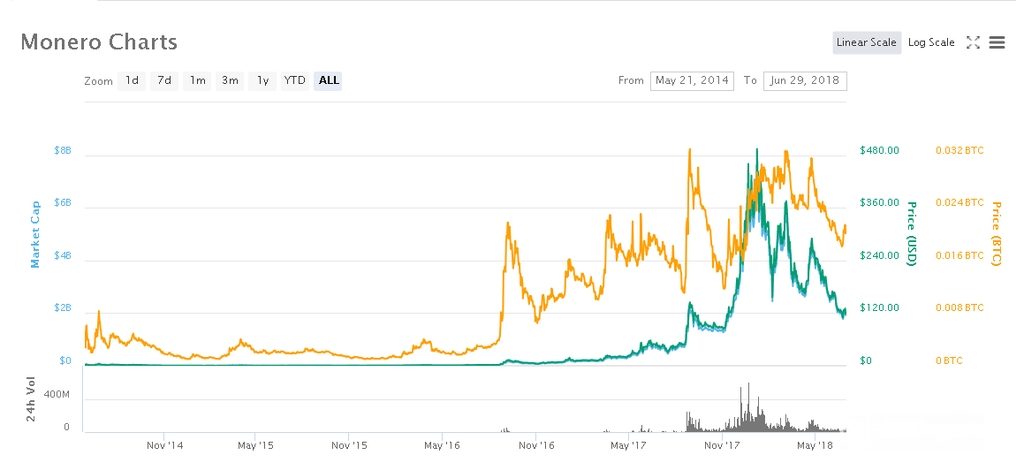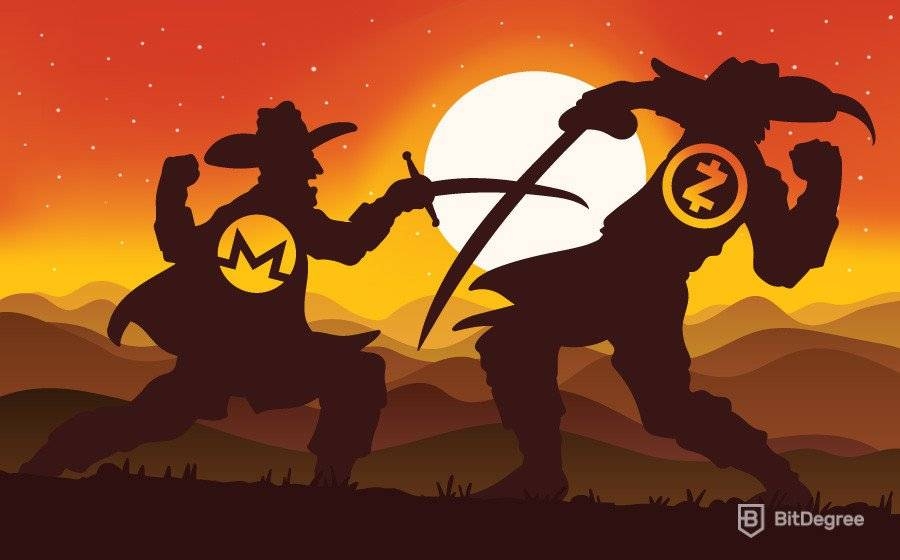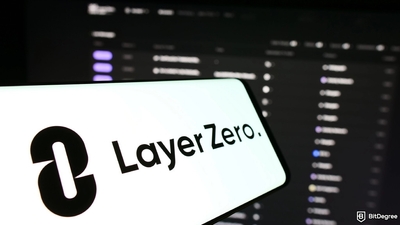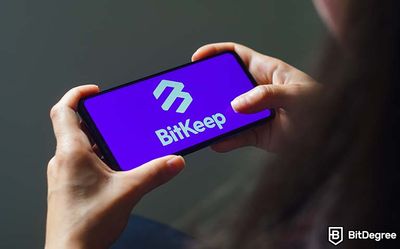Free Airdrop Season 7 is LIVE! Answer fun questions or do simple tasks to earn rewards from the $30K BitDegree prize pool. Participate Now ! 🔥
In this Zcash VS Monero guide, you’ll learn about the two coins’ histories and teams, the differences between their purposes and technical aspects, and be able to decide which it is you prefer over the other one. I’ll be explaining the following about each of these interesting, yet similar currencies.
Hopefully, by the end of this Zcash VS Monero guide, you’ll have a solid understanding of all the above points. This should help you to decide which one you wish to use or invest in. Either one you pick, make sure to only purchase these cryptos on reliable and established exchange platforms, such as Binance, Coinbase, Kraken, or KuCoin.
As you can see, there is a lot of stuff to cover in this Monero VS Zcash guide, so without further ado, let’s begin!

Did you know?
Subscribe - We publish new crypto explainer videos every week!
What is Yield Farming in Crypto? (Animated Explanation)


Table of Contents
- 1. Key Elements of Cryptocurrencies
- 1.1. Why Go Anonymous Anyway?
- 1.2. Back to the Basics…
- 1.3. Monero
- 1.4. Zcash
- 2. Monero VS Zcash: Fundamental & Technical Specs
- 2.1. Purposes
- 2.2. Speed
- 2.3. Adoption
- 2.4. In-Browser Mining and Crypto-Jacking
- 2.5. Online Publishing
- 2.6. Crypto-Jacking
- 2.7. In-Browser Mining and Charity
- 2.8. Problems with Adoption
- 2.9. Cost of Fees
- 2.10. Scalability
- 2.11. The Teams
- 2.12. Market History to Date
- 3. Zcash VS Monero: Comparison Chart
- 4. Zcash VS Monero: The Conclusion
Key Elements of Cryptocurrencies
To start this Zcash VS Monero guide, I’ll first take you back to before either coin existed. When the Bitcoin blockchain was first launched, many articles appeared about Bitcoin’s anonymous nature. It was the preferred currency for use on the dark web marketplace, Silk Road.
Latest Deal Active Right Now:Head to BitDegree Missions, gather as many Bits as possible & claim your stake of the $30,000 Prize Pool! Don't waste your time & start collecting Bits by completing Missions and referring friends.
Silk Road was the first of many services that allowed users to buy illegal goods and services online. It was therefore crucial that the currency used was completely private and untraceable. Unfortunately for many, this is not the case with Bitcoin.
Since the Bitcoin blockchain (database of transactions) is public, those who don’t use complicated additional privacy measures can easily be traced. With a little knowledge and careful study of the Bitcoin blockchain, it’s possible to uncover the identities of those making transactions.
Whilst it’s still true that Bitcoin transactions can be almost entirely anonymous, making them so requires many extra security steps. Such steps are often too complicated for the average user and for the developers of both Zcash and Monero, a different and more private cryptocurrency was needed.
Why Go Anonymous Anyway?
Before I get to the focus of this article – Zcash VS Monero – it’s important to discuss why someone would want to keep their identity a secret when making transactions. There are many of these reasons. Some are morally questionable, and others much less so. The reasons include:
- To buy substances deemed illegal in the part of the world you are living in. These can be used either medicinally or recreationally. Medical cannabis, for example, is perfectly legal in some parts of the world and it is not in others. It seems bizarre and completely unjust in a globalized world that the side of an imaginary line on a map you were born on should decide which medicines you’re allowed to use. Privacy coins allow people to access these substances without having to meet potentially dangerous people in person. They protect the identity of the buyer when making purchases.
- To pay for services that enable illegal acts. This could be malicious, as in software for use by hackers. It could also be non-malicious. Non-malicious uses of anonymous currencies include using gambling services in areas where games of chance are illegal and even paying people for services relating to free movement. For example, if a homosexual wanted to flee from a nation ruled by an oppressive government such as Saudi Arabia.
- Fungibility – another problem with Bitcoin’s blockchain is that it’s possible to see where a Bitcoin has come from. This is an issue since some vendors could choose to reject the payment if the funds have been used illegally in the past. This is not a good quality for money. Both Monero and Zcash make it so that no one can tell if a unit of either currency has been used illegally. As the Zcash motto states: “all coins are created equal”.
Back to the Basics…
Now that you know some of the many reasons why someone would want to use an anonymous currency lets looks closer at Zcash VS Monero. I’ve already established that both coins provide privacy to their users but there are other similarities and differences between the two projects.
I’ll first offer a brief description of the histories of each cryptocurrency before looking more at some of the specifics of them.
Monero
Monero was created in 2014. It was previously known as BitMonero. However, this was quickly shortened to simply to Monero.
Monero is a fork of an earlier cryptocurrency called Bytecoin. However, there was controversy over the launch of Bytecoin since 80% of it had already been mined before its release. Some of the developers and the community surrounding the project didn’t agree with this. They, therefore, forked Bytecoin in 2014. This fork would eventually become the currency that is now referred to as Monero.
Monero uses a different protocol for Bitcoin. It’s called CryptoNote. CryptoNote works by grouping many transactions. This makes it impossible to tell which one of the inputs (senders) each transaction belongs to. If you’ve ever heard of a Bitcoin mixing service, it’s kind of like one of those.
Like Bitcoin, Monero relies on Proof of Work to validate transactions. Proof of Work requires that computational power be used to update the Monero blockchain. The computer systems providing this power to earn rewards in the form of transaction fees, as well as newly minted coins for creating new blocks of transactions.
Zcash
Zcash was founded somewhat later than Monero in 2016. It started life as a project known as Zerocoin. This quickly changed to the Zerocash system. Finally, it became the version of the cryptocurrency we know today as Zcash.
Zcash is a fork of the Bitcoin codebase. This means that it’s much more like Bitcoin than Monero. One of the amendments that the Zcash team made to the Bitcoin codebase was the addition of zero-knowledge proofs called zk-SNARKS. This is how privacy is ensured for those transacting with Zcash. Without getting too technical, these zk-SNARKS can be used to conceal sending and receiving addresses, as well as the amount transacted.
Unlike Monero, Zcash is not private by default. Users must opt to send their payments privately. They can also send public payments. These work in a very similar way to Bitcoin transactions.
Zcash also features a reward for the team themselves. For the first four years of its existence (until 2023), 20% of the block reward will go to the developers, investors, and a non-profit foundation.
Monero VS Zcash: Fundamental & Technical Specs
To begin the head-to-head comparison of Monero VS Zcash, let’s start with their purposes.

Did you know?
Subscribe - We publish new crypto explainer videos every week!
10 Biggest Crypto Scams & How to Avoid Them (ANIMATED)


Purposes
The purpose of both Monero and Zcash is that they’re to be used only as currencies. This means that the developers behind both projects intended that each coin be used to make payments.
In the case of Zcash, these transactions can be private if the sender requests it, or public if that is their wish. In the case of Monero, transactions are only private.
The purpose of private transactions is to protect the identity of users for the reasons I mentioned earlier. Some feel it is their right to use their money in a way that is free from being looked at by others.
Speed
Next, in this Zcash VS Monero guide, I’ll look at each blockchain’s speed.
The Monero blockchain has a block time of two minutes. This means that new blocks are created every two minutes. This makes it around five times faster than Bitcoin to transact with.
Meanwhile, Zcash has a block time of around two and a half minutes. This makes it around four times faster than Bitcoin and a little slower than Monero to transact with.
With the Zcash blockchain, this speed depends on how busy the network is. If there are many people sending transactions at the same time as you, your transaction might not make it into the first block. It could take several blocks for it to be included. It’s also worth noting that private transactions take up much more space in each block. If the network was only processing private transactions, the network speed is around six transactions per second. This compares with just over 26 transactions per second is no additional anonymity is used by the transactions filling the block.
Monero works a little differently than this. It has a dynamic block size limit. This means the blocks grow and shrink in response to the demand for the network. The size of each block is based on the previous 100 blocks. This means if the network is processing many transactions, the block size will slowly increase giving the network greater capacity. There are some that claim that Monero can handle 1,700 transactions per second. However, this has never come close to being tested. For this to occur, the memory requirements would be far too great for many of the network’s nodes anyway.
Adoption
One of the areas that these two privacy-focused projects differ is with their levels of adoption. Monero seems to have found more use on the dark web than Zcash. This is because Monero is much easier to use than Zcash at present. There are few reliable wallets for the currency at present. However, being a relatively young cryptocurrency, this will certainly change.
Monero has found use cases on the dark web, by rogue states such as North Korea who want to get around international sanctions, and by groups of hackers. The ease with which it can be mined by regular computer systems has also led to some other interesting uses.
In-Browser Mining and Crypto-Jacking
Another area in which Monero has found adoption is for in-browser mining. This is because it’s still possible to mine Monero using just a GPU or CPU. In-browser mining involves running mining software from an internet browser. It’s very easy to do although not very efficient. However, if you get hundreds or thousands of computer users to use their electricity to do it for you, it can be very profitable.
Note: A CPU is a Central Processing Unit. All computers have a CPU. You can think of it as the brains of the computer. Meanwhile, a GPU is a Graphics Processing Unit. High-end gaming computers use GPUs. They’re more powerful than CPUs and are needed to display the high-quality images used in modern PC games. GPUs can mine for efficiently than CPUs.
Online Publishing
For some publishers of content, in-browsing mining represents a way to monetize a webpage without forcing advertising on their visitors. If it’s made clear that some of the computational power of a website visitor will be used to help fund the site, there is no real harm caused by this. The user is free to decide if they want to stay mining for the site or not.
Crypto-Jacking
Some publishers are not very forward about the fact that they are forcing users to mine cryptocurrency for them. Additionally, some download websites have hidden Monero mining software as part of the file users are downloading. Mining software is used on a computer without the owner’s permission is known as crypto-jacking. When we compare Zcash VS Monero, Monero is preferred for crypto-jacking because of its anonymous properties and the fact it’s still mineable using CPUs and GPUs.
In-Browser Mining and Charity
Finally, in-browser mining has been used for altogether more charitable causes. Children’s charity UNICEF launched a website called The Hopepage. The idea behind The Hopepage is that computer uses can visit the website and donate some of their unused computational resources to mining Monero for UNICEF.
When the website loads up, there is a clear option to start mining. The visitor is then asked how much of their computing power they would like to donate. If the tasks they are doing require a lot of power, they could just donate 20%. Or, if they’re just browsing some websites, they can donate up to 80%. At the time of writing, a massive 18,000 people were donating on The Hopepage!
Problems with Adoption
The Japanese Financial Security Agency (FSA) stated on June 18, 2018, that there will be a ban on anonymous coins. As well as Monero and Zcash, coins like DASH and Augur’s REP have also been targeted. The FSA has stated that the reasoning behind their move is to try to make it more difficult for cryptocurrency to be used for illegal acts.
If more countries follow the example set by Japan, the adoption rates of such privacy-focused coins could suffer greatly.
One of the areas that Zcash could win out over Monero in the war of the privacy coins is the fact that Zcash transactions don’t need to be private. This could help them avoid some potential regulatory issues in the future and may help them abide by “know your customer” requirements in various countries.
Cost of Fees
At the time of writing, the average Monero fee is around 90c. This has changed dramatically concerning the price of Monero. At it’s highest point, the cost of sending Monero was just over $20! Monero suffers the same scalability issues as Bitcoin.
Meanwhile, the average Zcash fee is incredibly low. It’s just 0.0001 ZEC. At the time of writing, this is less than 2c! According to Bitinfocharts.com, they have remained very low throughout Zcash’s existence.

Scalability
Blockchain scalability is one of the most pressing issues facing the entire cryptocurrency space. For a digital currency to truly be able to compete with the likes of VISA on a global scale, networks need to be able to handle much greater transaction volume than they can at present.
Monero has attempted to tackle scalability issues with its dynamic block size limit. However, as evidenced by the massive fees it has suffered from in the past, this is not enough to allow the network to be used by the entire planet.
Meanwhile, Zcash faces even worse scaling issues than Bitcoin. Since private transactions take up a lot more space in blocks than Bitcoin, if everyone wanted to make anonymous transactions, there would quickly be a race to the top of transaction fees. This was what happened to Bitcoin in the spring of 2017. However, there isn’t enough demand for Zcash for such a race to occur at present.
The Teams
When comparing cryptocurrencies, it’s always good to look at the teams behind the projects. That’s exactly what I’ll cover next in this Zcash VS Monero guide.
Monero Team
The Monero team is largely a secret. Two of the lead developers on the project are known. The others operate under aliases.
Riccardo “fluffypony” Spagni is the project’s leader and most vocal developer. Spagni lives in South Africa where he works on various cryptocurrency projects including Monero. He’s very active on Twitter under his handle @fluffypony. His educational background is in logistics and informatics. In addition to this, he has many years’ experience as a software developer.
Spagni is joined by Francisco “ArticMine” Cabañas and a long list of other developers’ aliases. Since so little is known about the team, I’ll have to cut this second short!
Zcash Team
Meanwhile, the Zcash team is much more open. The CEO and founder of the project are Zooko Wilcox. He’s a developer with more than 20 years’ experience in cryptography and data security. He’s very active on Twitter under the handle @zooko.
Zooko is joined by an experienced team of scientists. First is technician Eli Ben-Sasson. Eli is a respected lecturer at the Israel Institute of Technology. He’s also an expert at designing and applying proof systems.
Next is Alessandro Chiesa. Chiesa is a member of the Computer Science department at Berkeley University. He studied up to the Ph.D. level at the Massachusetts Institute of Technology.
These three are joined by a lengthy team of technicians and computer science experts. However, largely absent is a marketing team. This may limit the potential adoption of Zcash in the future.
Interestingly, some of the biggest names in the cryptocurrency space act as advisors for the Zcash project. The likes of Gavin Andresen, Vitalik Buterin, Arthur Breitman, and Dana Syracuse all aid the core team.

- Secure and reliable
- Accepts fiat currencies
- Lots of trading options
- Reputable exchange
- Accepts fiat currencies
- Offers various trading options

- Fiat currencies - accepted
- Simple to use
- Accepts only the most trustworthy cryptocurrencies
- A leading cryptocurrency exchange platform
- Best for beginner investors
- Accepts fiat currencies

- Beginner-friendly
- Secure
- Decent trading and withdrawal fees
Market History to Date
Monero
Monero was first created in the famous crypto bear (pessimistic) market of 2014. During its early years, the price action against the dollar remained constant. There were no great moves in either direction.
As the entire cryptocurrency market started to become bullish in the latter part of 2016, Monero too began to experience an uptrend. This got faster as 2017 progressed and by the mid-point of the year, Monero, like most other digital assets, saw explosive growth.
The price of a single Monero coin peaked in early 2018. This matched Bitcoin and any other cryptocurrency’s high points. The all-time high price of Monero was close to $500 per coin.
Since this high, the trend has largely been down with a few “bull traps” along the way. The price of a Monero coin at the time of writing (June 29, 2018) is currently around $120.
You can see the entire market history of Monero below.

Zcash
The Zcash price history follows a similar pattern to that of Monero (and many other cryptocurrencies for that matter). As you can see from the image below, after its launch it experienced sideways price action. The uptrend started a little later than Monero’s, however.
During the middle of 2017, the price started to increase versus the US dollar. You can see in the price graph that it stayed consistent with the price of Bitcoin throughout the year. As Bitcoin rose, so too did Zcash. When Bitcoin fell, so too did Zcash. That’s why the orange line representing the Zcash performance against Bitcoin remains virtually flat throughout the life of the coin so far.
You can see the full history of the Zcash price below.
Zcash VS Monero: Comparison Chart
| Founded | Total end supply | Total units at the time of writing | Current price in USD | All-time high in USD | Mining algorithm | Block time | Mining | Transactions per second | |
| Monero | April 2014 | 18,400,000 (+ 0.3 XMR/minute) | 16,180,000 | $119.98 | $494 | CryptoNote | 2 minutes | GPU/CPU | Theoretically unlimited |
| Zcash | October 2016 | 21,000,000 | 4,240,000 | $150.79 | $876 | Equihash | 2.5 minutes | GPU/CPU | Between 6 and 26 |
Zcash VS Monero: The Conclusion
So, that’s it. This Zcash VS Monero guide is all done! I hope you found it both entertaining and informative. I’ve covered loads in the guide. It’s probably best to have a quick recap of what you should have learned:
- The basics of Zcash VS Monero.
- The purposes of Zcash and Monero.
- Their transaction speeds.
- Adoption of Zcash and Monero.
- Scalability issues facing each team.
- The market history of Zcash VS Monero.
Now that we’re all done, what do you think about Zcash VS Monero? Do you think one coin will become the go-to privacy coin in the future? Or, do you think the two can exist together? We’d love to hear your thoughts!
Lastly, do also remember to check out Binance, Kraken, Coinbase, and KuCoin. Or, you may also take a look at some alternative exchange options, for all of your Monero or Zcash acquisition wants and needs!
The content published on this website is not aimed to give any kind of financial, investment, trading, or any other form of advice. BitDegree.org does not endorse or suggest you to buy, sell or hold any kind of cryptocurrency. Before making financial investment decisions, do consult your financial advisor.













